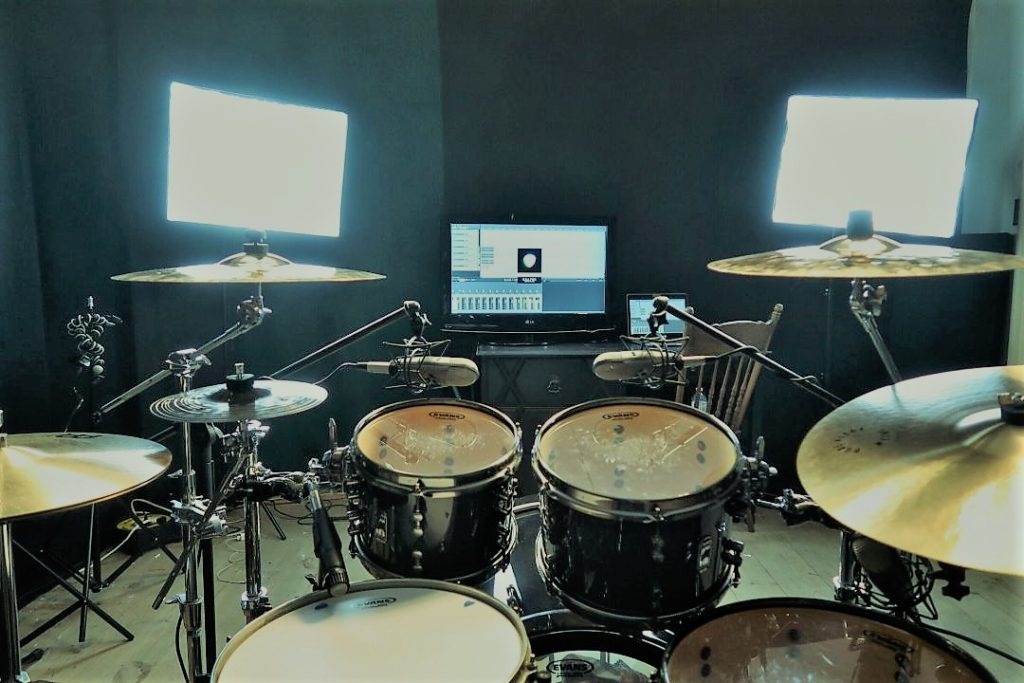Trying to learn how to record drums at home? If you’re anything like me, you’ve been dreaming about a home studio for a while.
Finishing my current home studio reached a level of excitement only comparable to getting my first drum set as a kid.
Despite all of that, building a home studio is neither cheap nor easy. Depending on how serious you’re about recording at home, you can easily spend thousands to finish your dream studio.
On the other hand, building a studio with a budget of $1.000 or less is also a possibility. Since I use different equipment live and at the studio, I didn’t want to spend too much buying premium gear twice and it worked quite well for me.
Either way, we are looking at a few months of research and planning, before we actually set up the studio.
On that note, our main focus for today is simplicity. By keeping it simple you don’t get discouraged before even starting, and you don’t spend more than you need to achieve a good result.
To summarize, the main goal of this article is to teach you how to record drums at home, including topics like essentials, preparing the room and its acoustics, and of course, how to avoid overspending.
Without further ado, here’s how to record drums at home without applying for a personal loan:
1- What are the essentials to record acoustic drums?
- Room;
- Acoustic Treatment;
- Drum Set;
- Computer;
- Interface;
- DAW Recording Software
- Drum Microphones;
- Monitor Headphones/Speakers;
- Microphone Stands, Cables, and other studio accessories.
1.1- Room

Before you plan anything about your home studio, you need to settle on a room first. In case you have multiple rooms to choose from, pick a medium-sized one.
Bigger rooms have a lot more echo, which we usually call natural reverb.
On the other hand, smaller rooms tend to sound dead because there’s less space to bounce between walls.
Do you remember how echoey it was when you bought your first house? And then, once it was fully decorated, there was no more echo, or at least not as much?
The same happens with your home studio and taking advantage of decorations is a must.
If your studio room has too much reverb, add more furniture to it. A few things you can add are a sofa, a rug under your drum set that also prevents it from sliding while reducing the vibrations or the reverb, and a basic desk.
The sofa is a matter of personal preference and the rug can be any drum rug you already own. Any of your mom’s old rugs will work just as well if you don’t own any drum rug. Just make sure it’s big enough to set up your whole kit on top.
In addition, the desk, or table, should be big enough to at least place a laptop or a desktop, an interface or a mixer, and your studio monitors.
Plus, it should be near a power outlet and include a few drawers or boxes to store tools like:
- Drum keys
- Screwdrivers
- Extra felts
- Extra wingnuts
- Anything that you might need but aren’t constantly using.
On contrary, if your room is too small and dead sounding, adding some wood panels to your walls can add some life to it. The wood improves sound reflection which is exactly what small rooms need.
Diffuser panels are a good example of wood panels that look good, and at the same time give a sense of spaciousness to your room. If you don’t want to overspend, make your diffuser panels out of regular plywood.
Don’t forget to make sure the room you choose is, or could be, comfortable enough all year round. You need a quiet place (be careful with A/Cs, heaters, fridges, etc.), that’s neither too hot nor too cold to use during extreme temperatures.
Plus, don’t forget to make sure it’s safe from floods or wildfires. No one wants to witness thousands of dollars in music gear disappearing overnight.
1.2- Acoustic Treatment
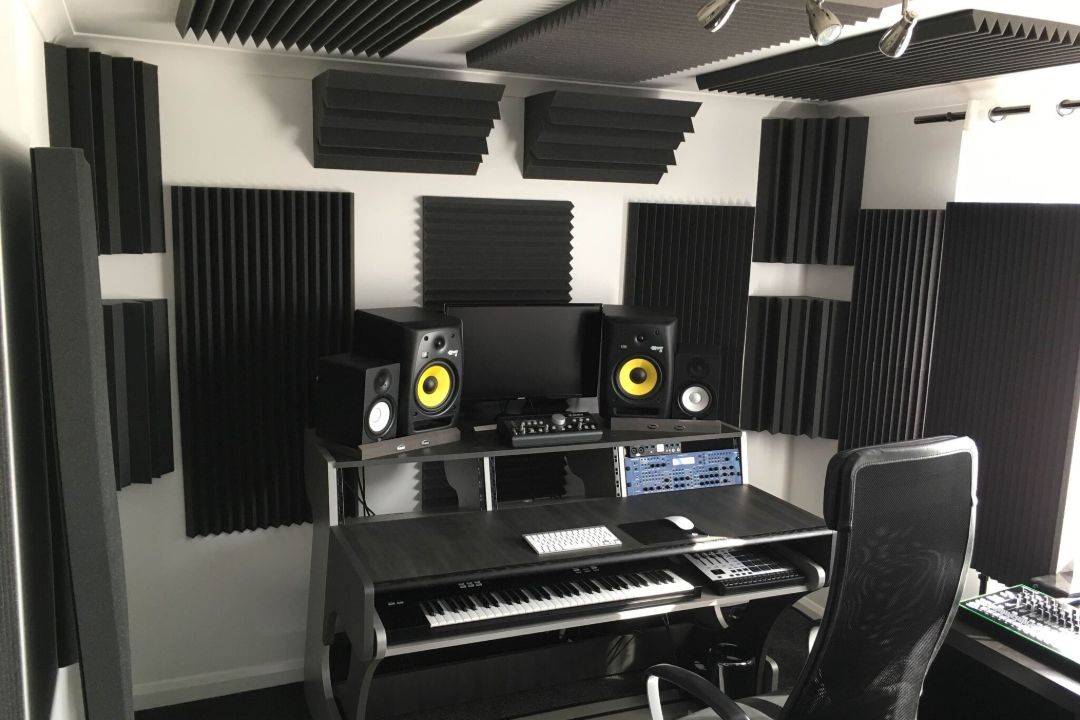
On that note, if the room available is too big, acoustic treatment becomes a necessity, instead of a luxury.
When you make any type of sound, it projects outwards in all directions with part of it reaching the microphone in a straight line (direct sound).
Additionally, the other part reflects off walls and other surfaces and eventually reaches the microphones.
Since it bounced off, the sound captured by the mics isn’t as natural and could potentially change the tone of the original sound.
To avoid that, you can invest in acoustic treatment. Depending on the room, the desired acoustic behavior, and the budget, you can combine foam or fabric acoustic panels with wooden acoustic treatments.
The first two reduce the reverb by preventing the sound from bouncing off of hard surfaces.
On the other hand, the wooden panels disrupt soundwaves to improve the tone when compared to steel, glass, or concrete surfaces.
Different Types of Acoustic Treatments
- Bass Traps: often placed in the corners of the room to deal with lower frequencies (fiberglass and foam);
- Acoustic Panels: reduce reverb by absorbing sound waves, but being thinner reduces their effectiveness with lower frequencies;
- Ceiling Clouds: reduce the excessive reverb in rooms with high ceilings. Usually made with foam and/or fabric, they are specifically designed for ceilings;
- Acoustic Foam: similar to acoustic panels, but sold in more of a raw material form. They are considered a heavy-duty acoustic treatment, and are mostly used at the studio instead of a business that needs acoustic treatment;
- Fiberglass Insulation: this is more soundproofing than acoustic treatment since its main goal is to prevent sound from entering or exiting the room;
- Helmholtz Resonators: with an (almost) spherical shape, a small neck, and a hole in both ends, they are less popular than the alternatives because they are not as effective for general use. On the other hand, they are perfect to resolve a specific frequency issue that might be causing some trouble;
- Diffusers: instead of absorbing the sound, these panels reflect sound waves in random directions. That reduces the natural reverb of the room.
1.3- Drum Set
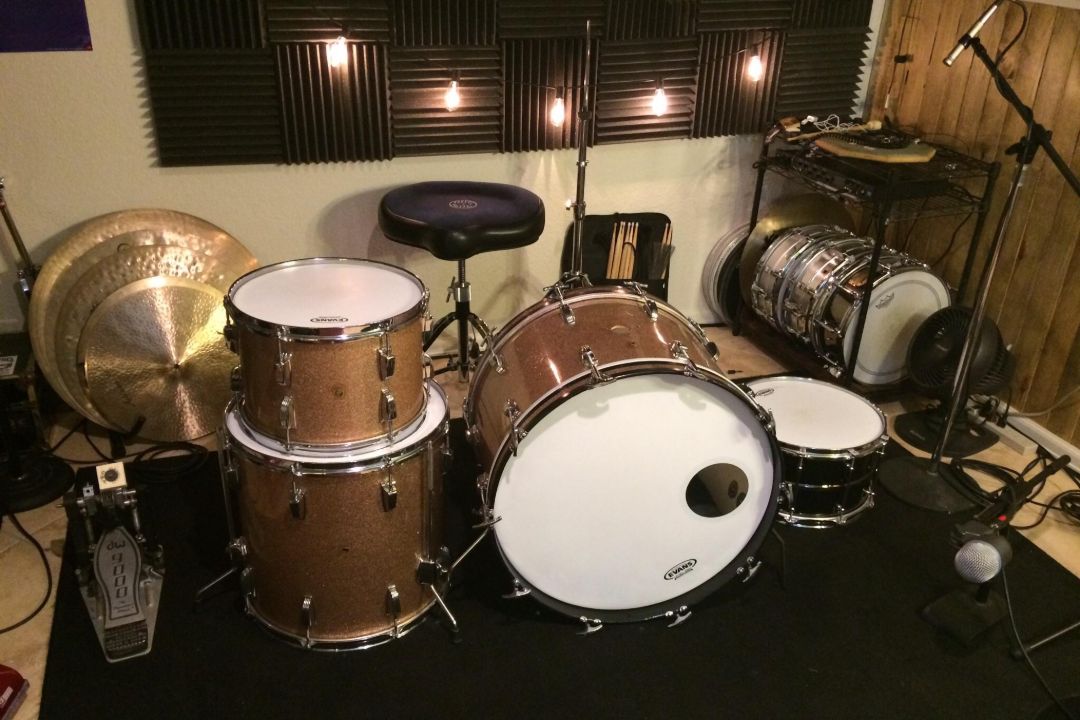
Now that you chose the place, it’s time to set up your drum set. If you’re looking at how to record drums, it’s highly unlikely that you don’t know how to.
It’s also pretty safe to assume that you already own a drum set if you’re planning to learn how to record drums.
Either way, if for some reason you don’t know how to set up a drum set, HERE’s my step-by-step guide.
Finally, with your drum set in place, it’s now time to do some much-needed maintenance:
- If your drum heads are too old and sounding dead, it’s time to change them. Loosen the tension rods and then remove the drum hoop and the old drum head. Place the new drum head on the drum with the hoop on top and tighten back every tension rod.
- Basic maintenance is something that you should do periodically. If you don’t, take some time to do so before tightening back every tension rod. Check for missing screws, broken tension rods, throw-offs that don’t work properly, squeaky bass drum and hi-hat pedals, and everything else you can think of.
- With new drum heads, tune them high if you play more jazz or pop, and low if you play rock or metal most of the time. If you have a hard time tuning by ear, it might be time to invest in a drum tuner. HERE’s my article on the best drum tuners and step-by-step guides on how to use every single one of them.
- In the end, if your tuned drums have too many overtones and extra buzzing, it’s time to use some dampening tools like silicon gels, dampening rings, duct tape, Remo Muff’l Control rings, pillows, or blankets (for the bass drum).
At this point, with everything set up and some basic maintenance concluded, all you need is a competent drummer… and a room full of studio gear.
1.4- Computer
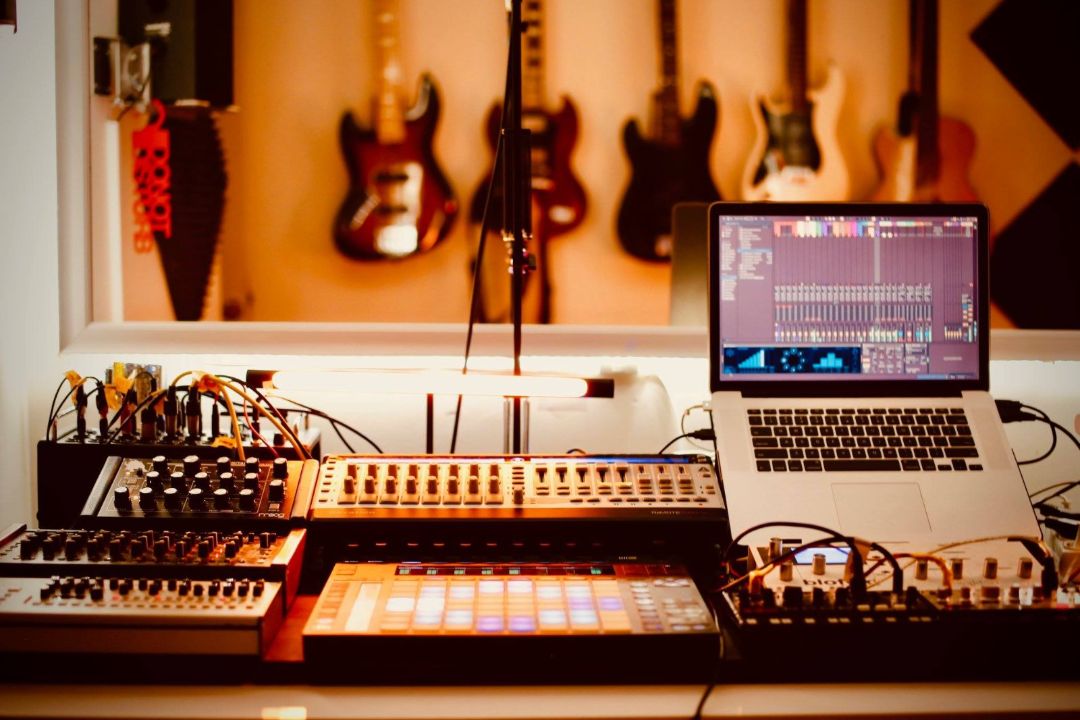
Besides the drum set, the computer is probably where you spend the most when building a home studio.
Thankfully for us, in this day and age, most people own a computer of some sort. In that case, unless it’s a 10-year-old computer or worse, it’s probably fast enough to mix and produce music.
With that in mind, I recommend using what you have for now, until you feel it’s slowing you down.
If you need or want an upgrade, HERE’s a good article by MusicRadar on the best computers for music production.
In general, you need a PC with at least 8Gb of RAM, preferably 16Gb, running a Core i5 processor from the past three years and at least 1TB of memory, between HDDs and SSDs.
Go for a laptop if:
- It’s useful for additional activities like college or live performances;
- You travel a lot and need to produce and mix music on the go;
- There’s not enough space in your studio for a full desktop PC.
Go for a Desktop PC if:
- Most laptops don’t offer enough processing power for the type of music you plan to produce;
- You’re on a budget and can’t afford to pay the premium for a laptop;
- You value upgradability over portability;
- The goal is to invest in a powerful stationary machine focused on music production.
1.5- Audio Interface
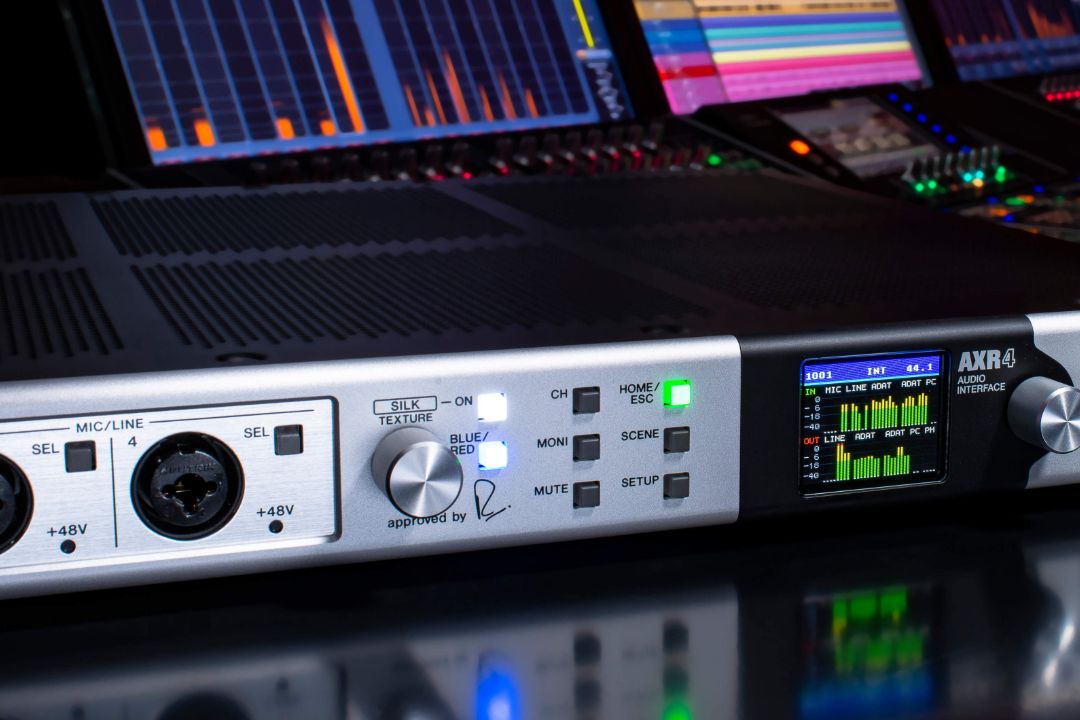
The main job of an audio interface is to convert the signals coming from musical instruments and microphones into a format recognizable by the DAW on your computer.
You can simply look at it as a bridge that connects all your musical instruments and microphones to the computer, but also allows you to get sound out of your computer through headphones and speakers.
Newer audio interfaces connect to your computer through USB, but Firewire and Thunderbolt connections are also available. For the sake of simplicity, buy an interface with a USB connection.
As a drummer, the most important feature of an audio interface is its number of XLR inputs. Considering any basic 5-piece drum kit needs at least 7 microphones, you need to look through audio interfaces with 8 XLR inputs.
It’s important to remember that cheaper also means lower-quality audio interfaces. What comes with lower quality is bigger latency (known as lag) and static noise, but for a home studio, they work just fine.
With that in mind, these are the most popular audio interfaces (with 8 XLR inputs) among drummers:
- Behringer Uphoria UMC 1820 (the one I own and the cheapest available in Europe)
- Tascam US 16×08 (another cheap option if you’re in the US)
- Focusrite Scarlett 18i20 (great sound quality, top-rated)
- PreSonus Studio 1824c (good price-quality ratio)
- Roland UA-1010 Octa-Capture (mid-tier quality option)
- Steinberg UR816C (made by one of the best in the interface world)
- Focusrite Clarett 8Pre USB (premium option).
Wanna read more about the subject? HERE’s my article on the best audio interfaces for drummers.
If you’re anything like me and only plan on doing some amateur recordings, both the UMC 1820 and the US 16×08 work well enough. The Focusrite Clarett 8Pre USB is the best option under $1.000 for professional sounding sessions.
1.6- DAW
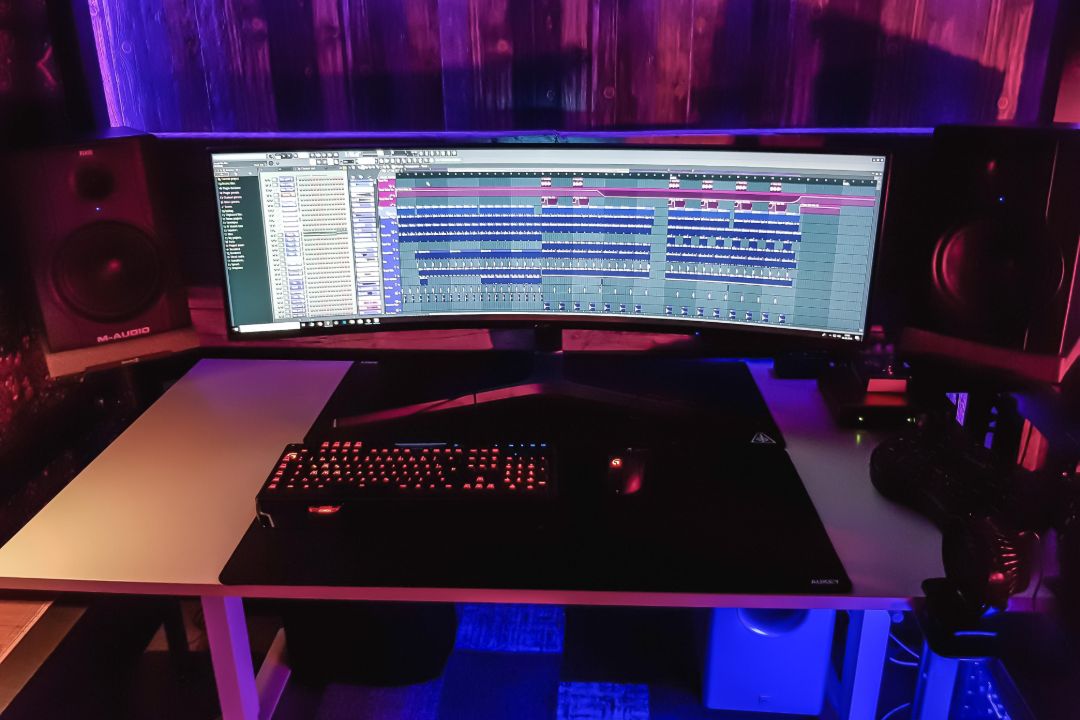
DAW, or Digital Audio Workstation, is the software you use to make music with all the hardware at your new home studio.
To summarize, you can record a live or virtual instrument and/or voice, loop, edit and mix audio, or simply turn MIDI notes into printable sheet music.
Some DAWs are ideal for beginners, while others are far more advanced. There’s also an option for every wallet since their price range goes from free to a few hundred dollars a year.
I’m not going into detail, but here are the most popular Digital Audio Workstations:
- Logic Pro X – $200, available for mac, used by David Guetta, Swedish House Mafia, and Hardwell;
- Ableton Live – $99, available for pc and mac, the preference of EDM gods like Skrillex and Deadmau5;
- Avid Pro Tools – industry standard, $30/month (has a free version), available for pc and mac, used by Dr. Dre and Kanye West;
- GarageBand – free with all Macs, not available for pc, projects compatible with Logic Pro and GarageBand mobile, lacks advanced features;
- Audacity – free, lacks advanced features and the interface is completely outdated;
- FL Studio – $99, available for mac and pc, ideal for EDM, lifetime updates;
- Cubase – $100, available for mac and pc, one of the original DAWs.
1.7- Drum Microphones
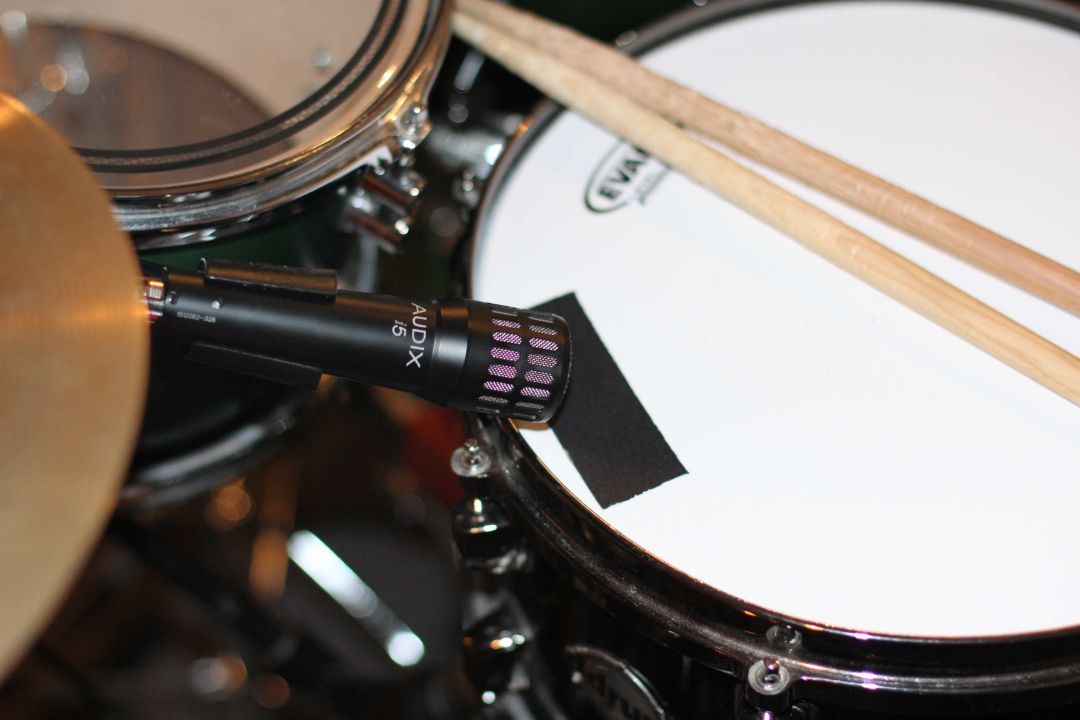
With an acoustically treated room, a well-tuned drum set, and an interface connected to a computer with a ready-to-use DAW, it’s now time to pick the microphones.
Your two options are buying individual mics, or just grabbing a drum mic kit. If you’re a beginner, or someone on a tight budget, buying a drum mic kit is the smartest decision.
Drum mic kits are cheaper than the alternative, and leave no room for mistakes since every mic that comes with it is perfectly labeled and serves a purpose.
The number of mics you buy depends on how many XLR inputs your interface has. In this article, I focus on interfaces with eight inputs simply because having a separate mic on each drum gives you the most control over your sound.
That doesn’t mean you can’t record drums with less than seven mics, since there are specific techniques to record with anything from one to six microphones.
Before diving into my suggestions, let’s take a look at the 3 main types of microphones:
- Dynamic: the least sensitive, least expensive, and most durable microphones. They are seen as a versatile workhorse often used to record snare, bass drum, and toms;
- Condenser: more sensitive than dynamic mics, they offer the widest frequency response. In a drum studio, their job is to capture the cymbals. Plus, as overheads, they also contribute to the overall sound of the drum set.
- Ribbon: extra sensitive, paired with much greater fragility. They capture honest and accurate representations of the sound source, which is why they are often used as “room mics”, and sometimes as overheads. Due to being the most expensive type of mics, you rarely find them in home studios.
With that out of the way, here are the best drum mic kits you can buy:
- AKG Drum Set Session I – 7 microphones, cheap, good sound for the price, reputable brand;
- Shure PGADRUMKIT7 – 7 microphones, 7 XLR cables, entry-level price, reputable brand;
- Audix DP7 – 7 microphones, instructional DVD, one of the best under $1000 kits;
- Sennheiser e600 – 7 microphones, pro-sounding, reliable, reputable brand;
- Earthworks DK7 – 7 microphones, professional studio sound quality, expensive;
If you want to learn more about each drum mic kit, HERE’s my article about the best drum mic kits currently available.
In case you would rather invest in individual mics to increase the control of the sound you achieve, here’s a few industry standards and how to set them up:
Bass Drum Mic
As far as the bass drum goes, you record it with a dynamic cardioid mic as we’ve seen before. The difference is, they’re usually bigger than regular dynamic mics, to easily capture the low-end frequencies.
With that in mind, here are the best bass drum mics:
- AKG D112 – industry-standard, reliable, durable, and fairly priced (even better if you’re from Europe);
- Shure Beta52A – another industry standard, versatile, durable, and great in both the studio and live performances;
- Audix D6 – sounds good, punchier sound with an increased attack, well built;
- Sennheiser e602 II – a simple alternative that’s both consistent and reliable.
Bass drum mic placement:
- One mic outside the resonant drum head: attach the mic to a short mic stand and place it outside the front drumhead, about 1” to 3” away, in the bottom third of the head;
- A single mic near the resonant drum head hole: alternatively, you can place the bass drum mic directly in front of the drum head hole, or even an inch or two inside, using a short mic stand;
- One mic laying inside the bass drum: most people use a pillow, blanket, or foam to reduce the sustain. You can them lay a mic on top of them, inside the kick, improving the low end and saving money on an extra mic stand.
Snare Drum Mic
A snare drum is usually recorded with a regular dynamic cardioid mic on top, or one on top and one at the bottom. For the sake of simplicity, and considering we have a budget to follow, let’s work with one mic only.
As of today, the best snare drum mics are:
- Shure SM57 – industry standard, durable, and with an insane sound quality considering how affordable it is;
- Audix i5 – entry-level option, decent sound, affordable and durable;
- Beyerdynamic M201TG – premium option, great sound and build quality, but expensive.
Snare drum mic placement:
There are two common ways to place a mic on a snare drum:
- Some snare mics come with a clip so you can easily clamp it to the snare drum hoop. Getting the mic closer to the snare provides more attack, while further away increases the warmth tones;
- If a clip isn’t included with the mic, you need to use a mic stand, like the ones you would use for overhead mics. How far the mic is from the snare affects the way it sounds on your recording, so make sure you experiment with it until you find the sweet spot.
Tom Drum Mic
Tom mics are, most of the time, sold as a pack of three, but buying them individually is also common. To save some money, buying a pack of five with a snare and bass drum mic included is always a great decision.
On that note, the toms are often recorded with a dynamic cardioid mic, just like the snare and bass drum.
Here are the best tom mics on the market:
- Sennheiser E604 – affordable, good sound quality, and reliable. Sold individually, in a pack of three, or as part of the 600 mic kit;
- Sennheiser MD-421 II – insane sound, widely trusted by professionals, versatile but expensive and bulky;
- Audix D2/D4 – good sound quality, affordable and perfect design. D2 for tom-toms and D4 for floor-toms since it was designed to get the best out of low-frequency drums.
Tom drum mic placement:
- More often than not, tom mics include a clip so you easily clamp it to tom hoops. You don’t want to break an expensive mic, so make sure they are not in your way. Adjust the angle to get them closer or further from your drumhead until you’re satisfied with the sound.
- If a clip isn’t included, you need to use a mic stand like the ones used with overhead mics. Adjust the proximity and the angle until you achieve the desired sound.
Overhead mics
Overheads are usually two condenser microphones, placed in mic stands above and pointing down over the drum kit.
Since they handle high frequencies well, they are used in recording and live sessions to capture the cymbals and overall sound of the drum set.
Buying them as a pair is the most logical financial decision, but that’s not always possible, especially with expensive mics.
Some of the most popular overheads mics:
- Neumann KM 184 – industry standard, clear, detailed but expensive;
- Rode M5 – best budget option, good sound and reliable;
- Shure KSM 137 – good and clean sound, perfect for someone that doesn’t want the budget or the premium option.
Overhead mics placement:
- Place each mic on its own mic stand and place one near the Hi-Hat/Left Crash and the other near the Ride/Right Crash;
- Point their diaphragm (where you speak into) to your snare drum and make sure they are both at the same distance from the center of the snare;
- If they are not, grab a tape measure or a mic cable and adjust accordingly. Their height doesn’t matter as long as the distance to the center of the snare is the same for both.
Room or Hi-Hats mics could be added to the list, to achieve a full and rich sound or to capture the Hi-Hat that doesn’t sound good with your current overhead mics’ configuration.
On the other hand, and since the goal is to learn how to record drums at home by building a drum studio with a limited budget, these are far from essential and should be ignored for now.
1.8- Monitor Headphones/Speakers
1.8.1- Monitor Headphones
Every drummer needs a good pair of headphones to either listen to the music and/or click-track he’s playing along with or to mix a record.
In a perfect world, you have a pair for each application, but for a home studio, one good pair of headphones is enough.
The two main headphone types are open and closed, and your decision should fall on how much sound isolation you want (closed > open).
I have a comprehensive guide on the best headphones for drummers you can read HERE.
If you want a summary, here are some good options:
- Vic Firth Stereo Isolation Headphones V2 – decent sound, good isolation, affordable but uncomfortable during extended periods (especially with glasses);
- Sennheiser HD280 Pro – good sound quality, decent isolation, and average price;
- Beyerdynamic DT 770M – amazing sound, comfortable and fairly price;
Either way, if you already own a pair of headphones that you can work with, there’s no need to invest in a new pair for your home studio.
1.8.2- Monitor Speakers

Monitor Speakers help you mix your music and stop you from constantly wearing headphones and damaging your hearing.
In terms of headphones vs speakers, it’s all a matter of personal preference. For me, no studio feels complete until it includes a pair of monitor speakers.
If you’re thinking about purchasing a new set of monitor speakers, here’s a summary of the best options on the market:
- KRK Rokit 7 G4 – good and balanced sound quality, awesome design, and affordable price;
- Focal Shape 65 – clear sound, controlled response, and fairly priced;
- Focal Twin6 Be – best seller, precise sound image and versatile.
Your decision should be based on the budget available, how big your room is, and what your current headphones are (if you own any).
1.9- Microphone stands, cables and other studio accessories
Even though they are not that exciting, no studio is complete without the following accessories:
1.9.1- Microphone Stands
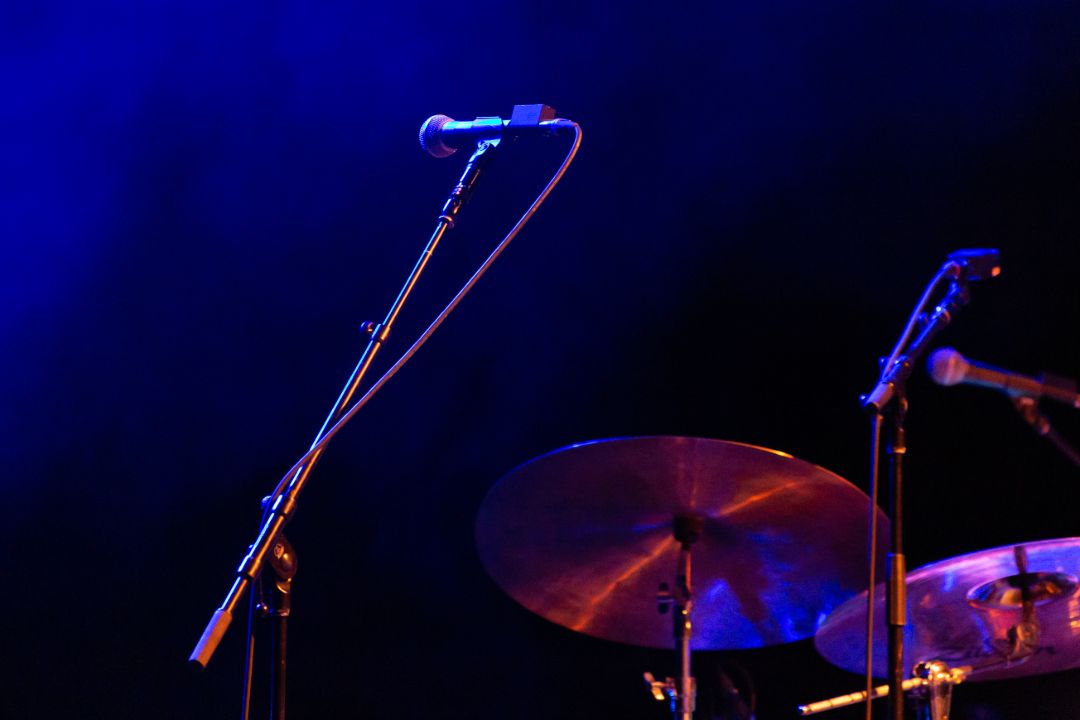
The number of microphones stands you need depends on the number and the type of microphones you plan to use.
With the standard 7 mics recording technique, you need at least two microphone stands for the pair of overheads and one for the bass drum mic (unless you leave it on top of a pillow inside the bass drum).
The snare drum mic doesn’t have a clip? Well, now you need four. If neither the tom-toms nor the floor-tom mics come with a clip, then you need as many as seven microphones stands to accommodate every single microphone.
Anyway, the microphone stands are divided into half a dozen categories: tripod stands, tripod boom stands, round base stands, low-profile stands, desktop stands, and overhead stands.
For us, drummers, the most common ones are low-profile stands (for the bass drum mic) and overhead mic stands (for the pair of overhead mics).
I say this a lot, but as far as the microphone stands go, you should always get the best your budget allows you. No one wants to live through the scary experience of watching one of their mics hit the floor.
Some of the best and most popular microphone stands are:
- K&M (210/9; 25950; 210/2)
- Hercules (MS533B)
- Atlas Sound (MS-10C; MS-12C; MS-20)
1.9.2- Cables

Another important thing in any home or professional studio is a set of cables, especially the XLR ones.
You want to avoid the cheapest ones, because they tend to break quickly, don’t work at all and you probably won’t be able to activate the warranty.
Since the topic is all about recording drums at home, you don’t need the best of the best either.
In the end, just pick something that costs between $20 and $40, because it usually combines a good amount of quality and affordability.
To identify the length of the XLR cables you should buy, don’t forget to measure the distance between your interface and your drum kit, and then add a couple of feet for good measure.
Some of the best XLR cables manufacturers, in terms of build quality, performance and variety are:
- Mogami;
- Sommer;
- Klotz;
- Cordial;
- Pro Co;
- D’Addario.
Besides XLR cables, every studio should own USB and MIDI cables, as well as Cat5e and of course, some spare power cables.
Slightly less important but still essential are the TRS, TS, and RCA cables. Your future self will thank you for buying them.
1.9.3- Studio Accessories
Accessories are always overlooked, but most only find out how important they are when they need them the most.
Some of the accessories any drum studio eventually needs are:
- XLR to TRS;
- RCA to TS adaptors;
- Speaker Stands;
- Laptop Stands;
- Cable Holders (Velcro cable ties or duct tape work well enough);
- Pop filters;
- External Storage;
- Ergonomic chair;
- Good lighting.
Final Thoughts
Well, that’s it. Learning how to record drums isn’t easy, but buying all the necessary gear is by far the hardest part.
Not everyone has thousands upon thousands of dollars to build a decent home studio from scratch.
Thankfully, with enough research and imagination, you too can build your home studio for less than $2.000 or even $1.000.
On top of that, you probably already own some of the gear listed in this article, or at least something similar.
Plus, no one claims you need to finish your home studio in a week. Most musicians accumulate music gear for years, or even decades, before they’re satisfied, and the same can be done with a drum studio.
In the end, I hope this article achieves its main purpose of educating you on all the necessary gear to build your home studio, and how to record drums from the comfort of your home.

